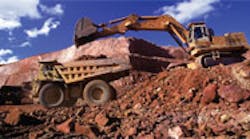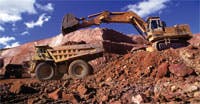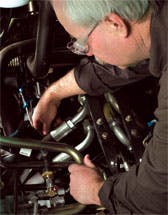Demands on today’s hydraulic hoses vary across the board. Some need to handle only modest pressures, other must perform flawlessly despite extreme pressure spikes. Operating temperatures can ranges from Antarctic cold to extreme heat in steel mills and foundries. And modern hoses must deal with a plethora of fluids, from standard petroleum-based offerings to synthetics, biodegradable, and water-based versions.
Regardless of the application, however, all hoses consist of three basic components: tube, reinforcement, and cover.
The inner tube, made from synthetic-rubber compounds and composites, must be chemically compatible with the working fluid. Special compounds may be required to handle fire-resistant fluids. The tube must also resist corrosion and deterioration and the effects of high or low temperatures.
Reinforcement allows the hose to handle fluid pressures and pressure spikes, and prevents premature hose bursts when properly used. It determines the working pressure of the hose. Hoses with low working pressures normally use textile-fiber reinforcement, while those handling higher pressures generally use high-strength steel wire.
Steel-reinforced hoses, in turn, fall into two categories: braid and spiral. Wire-braided hose handles working pressures to 6000 psi, depending on size, with one or two braid layers. Spiral hose, which generally handles high pressures in larger diameters, has wire spiraled around the tube on a bias, with successive layers laid at opposing angles. There are typically four or six layers of steel reinforcement. In braid and spiral hose, rubber layers separate layers of steel wrap to ensure good adhesion throughout the hose wall.
The cover protects the tube and reinforcement from heat, abrasion, and corrosion, as well as environmental deterioration from heat, cold, UV light, and ozone. Covers are made from synthetic rubber, fiber braids, or a fabric wrap, depending on the application.
Specifying hose
When specifying hydraulic hose, experts agree it’s important to understand the relationship between reinforcement and pressure ratings across different classes of hose.
Very-high and extremely high-pressure hose is used in off-highway equipment and heavy-duty machinery subject to extreme impulse or pressure surges. These hoses are reinforced with spiraled, high-tensile steel wire wound over the tube in alternating, even-numbered layers to balance pressure and containment forces. The hoses are often called four-wire for high pressure and six-wire for extremely high-pressure hose, though the actual number of spiral-wire layers varies with hose ID. Most spiral hose with an ID of 1 in. or less has four layers.
Spiral reinforcement is particularly suited to high-pressure impulse applications because individual wires in each layer are parallel, and thin rubber-adhesion layers separate adjacent reinforcement layers and keep the wires from cutting one another.
Spiral construction packs the reinforcement tighter around the tube than does braid reinforcement and, therefore, provides more support. Individual ends or strands can be bound tightly together as opposed to the over-under gaps with braiding. However, braided hose is generally more flexible than spiral hose.
High-pressure hose is mainly two-wire braid construction with high-tensile-strength steel reinforcement. It is frequently used on construction equipment and similar applications. Operating pressures range from 6000 psi for a 316-in. ID to 1825 psi for 2-in. ID. Some proprietary hoses, such as Gates M3K and M4K, have the same pressure rating for all sizes.
Medium-pressure hoses handle hydraulic applications requiring operating pressures of 300 to 3000 psi. They may have one-wire steel-braid reinforcement or multiple wire and/or textile-braid construction.
Low-pressure hydraulic hoses withstand operating pressures to 300 psi. Reinforcement is usually textile. They are found on low-pressure hydraulic applications and transmit petroleum-based fluids, diesel fuel, hot lubricating oil, air, glycol antifreeze, and water. Some, such as Global MegaVac (GMV), are also rated for suction applications.
Specialty hydraulic hoses do not fit well into a particular pressure category. For example, specialty hose might be used with environmentally friendly hydraulic fluids, for operating at extremely high or low temperature, or requiring electrical nonconductivity. They may be specified where weight is a concern or long continuous lengths are required. Reinforcement is generally nonmetallic — usually a rubber-impregnated fabric.
Standard constructions
To bring a measure of uniformity to hydraulic-hose manufacturing, minimum standards for construction, dimensions, and performance have long been established in North America by SAE.
In other parts of the world, organizations such as the European Norm/Standard (EN), Deutsche Industrie Norm (DIN), and the International Standards Organization (ISO) also set standards, which may differ from those of SAE. Governmental agencies also set standards. Among them are the Mine Safety & Health Administration (MSHA) and the Department of Transportation’s Federal Motor Vehicle Safety Standards.
SAE Standard J517 provides general, dimensional, and performance specs for the 100R hose series, which are the most common hoses used in hydraulic systems. See the accompanying sidebar, “SAE hose constructions,” for more details.
Exceeding SAE specs
Some manufacturers have developed hoses that far exceed the performance and construction requirements of SAE specifications. Benefits to users include higher pressure and temperature capabilities, greater flexibility, and a bend radius as little as one-half that of the SAE standard.
One such product is Gates M-XP hydraulic hose, which combines the flexibility of wire-braid construction with the strength and performance of spiral-wire reinforcement. The result is an economical, two-braid wire hose that handles 4000-psi high-impulse duty in all sizes.
M-XP hose is rated for 1,000,000 impulse cycles (at 100°C), which exceeds the SAE standard of 200,000 impulse cycles and the Gates minimum requirement of 600,000 impulse cycles for typical wire-braid hoses. A high cycle rating equates to longer service life and makes the hose suited for out-of-sight and hard-to-reach applications such as boom arms and scissor lifts on mobile and construction equipment.
The hose also has half the minimum bend radius of equivalent SAE-rated hose. This means it tolerates tighter bends without compromising performance or life. In some installations, this can reduce the required hose length by nearly 50%. Greater flexibility also makes it easier to install in confined spaces.
Another advantage is that rather than needing expensive spiral-wire couplings, M-XP hose can use less-costly, one-piece MegaCrimp couplings that are also rated for ≥1,000,000 impulse test cycles. The assemblies meet MSHA flame-resistance requirements.
Dennis Kemper recently retired from the Gates Corp., Hydraulic Div. after more than 30 years of service in various technical and management positions, most recently as global product application manager. For more information on Gates MX-P hose, visit www.gates.com/mxp.
SAE hose constructions
Here’s an overview of SAE J517 specifications. Unless otherwise noted, each hose has an oil-resistant, synthetic-rubber inner tube compatible with petroleum and water-based hydraulic fluids, an oil and weather-resistant synthetic rubber cover, and an operating temperature range from –40 to 100°C.
SAE 100R1, Type A hose has one braid of high-tensile-strength wire around an oil resistant tube (commonly nitrile), and an oil, weather, UV, and ozone-resistant cover commonly made of NBR or NBR/PVC blend. Type AT has the same construction as Type A, except the cover does not need to be removed to assemble with fittings. Type S has the same construction as Type AT and working pressures of ISO 436-1, Type 1SN.
SAE 100R2 hose has two braids of steel-wire reinforcement. A ply or braid of suitable material may be used over the inner tube and/or wire reinforcement to anchor the rubber to the wire. Type A requires skiving (removing) a portion of the cover to assemble with fittings. Type AT has the same construction as Type A, except the cover does not need to be removed to assemble with fittings. Type S has the same construction as Type AT and working pressures of ISO 1436-1, Type 2SN.
SAE 100R3 hose has two braids of textile yarn. It is generally used in low-pressure applications with petroleum oils, antifreeze, or water.
SAE 100R4 hose has one or more plies of woven or braided textile fibers with a spiral of body wire. It’s typically used for return and suction lines.
SAE 100R5 hose is reinforced with two textile braids separated by a high-tensile-strength steel-wire braid. All of the braids are impregnated with an oil and mildew-resistant synthetic rubber compound.
SAE 100R6 hose includes one braided or spiral ply of textile yarn. It’s for general-purpose, low-pressure applications.
SAE 100R7 thermoplastic hose should be used with synthetic, petroleum, and water-based hydraulic fluids at temperatures from –40 to 93°C. It consists of a thermoplastic inner tube resistant to hydraulic fluids with synthetic-fiber reinforcement and a hydraulic fluid and weather-resistant thermoplastic cover. Nonconductive 100R7 is identified with an orange cover and appropriate layline. Pressure capacity is similar to that of 100R1.
SAE 100R8 high-pressure thermoplastic hose should be used with synthetic, petroleum, and water-based hydraulic fluids within a temperature range from –40 to 93°C. It has a thermoplastic inner tube resistant to hydraulic fluids, synthetic-fiber reinforcement, and a hydraulic fluid and weather-resistant thermoplastic cover. Nonconductive 100R8 is identified with an orange cover and appropriate layline. Pressure capacity is similar to that of 100R2.
SAE 100R9, SAE 100R10, and SAE 100R11 hoses types have been removed from the SAE standard.
SAE 100R12 hose should be used with petroleum and water-based hydraulic fluids within a temperature range from –40 to 121°C. It has four spiral plies of heavy wire wrapped in alternating directions. A ply or braid of suitable material may be used over the inner tube and/or over the wire reinforcement to anchor the synthetic rubber to the wire.
SAE 100R13 hose is for petroleum and water-based hydraulic fluids within a temperature range from –40 to 121°C. Multiple spiral plies of heavy wire wrapped in alternating directions cover the inner tube. It’s for high-pressure applications subject to surges or flexing.
SAE 100R14 hose handles petroleum, synthetic, and water-based hydraulic fluids within a temperature range from –54 to 204°C. Type A consists of an inner tube of polytetrafluorethylene (PTFE) reinforced with a single braid of stainless steel. Type B has the same construction as Type A, but with the additional feature of an electrically conductive inner surface to prevent buildup of electrostatic charge.
SAE 100R15 hose should only be used with petroleum-based hydraulic fluids within a temperature range from –40 to 121°C. It has multiple spiral plies of heavy wire wrapped in alternating directions. A ply or braid of suitable material may be used over or within the inner tube and/or over the wire reinforcement to anchor the rubber to the wire.
SAE 100R16 hose has one or two braids of steel-wire reinforcement. It’s for high-pressure hydraulic applications requiring tight bends and high flexibility.
SAE 100R17 hose, with one or two braids of steel-wire reinforcement, has a constant working pressure rating of 3,000 psi.
SAE 100R18 thermoplastic hose should be used for synthetic, petroleum, and water-based hydraulic fluids in a temperature range from –40 to 93°C. It has a thermoplastic inner tube that resists hydraulic fluids, synthetic-fiber reinforcement, and a hydraulic fluid and weather-resistant thermoplastic cover. Nonconductive 100R18 is identified with an orange cover and appropriate layline. Working pressure rating is 3,000 psi for all sizes.
SAE 100R19 hose has a constant working pressure rating of 4000 psi in all sizes. It has one or two braids of steel-wire reinforcement. A ply or braid of suitable material may be used over the inner tube and/or wire reinforcement to anchor the rubber to the wire.







